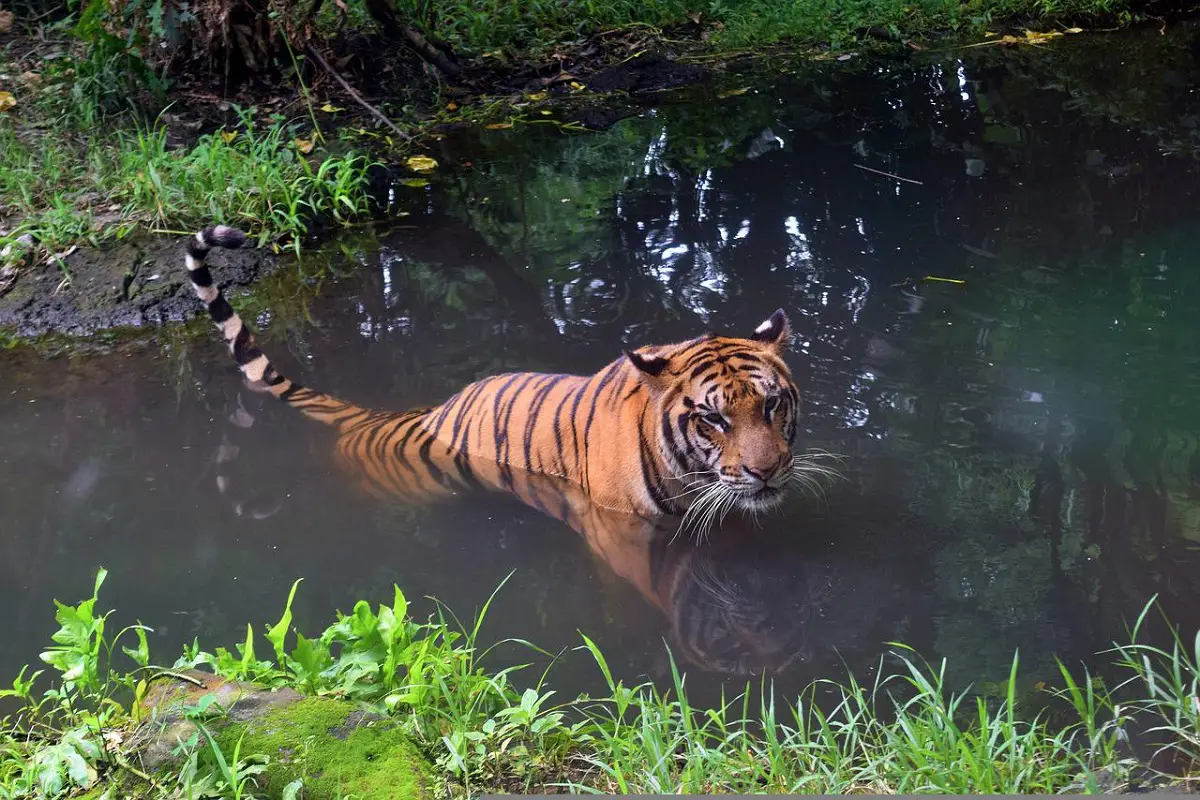Tigers are some of the most famous and instantly recognizable members of the genus Panthera. This group of animals covers most of the big cats, including leopards, lions and of course Panthera Tigris.
There were once 9 different subspecies of tiger located in multiple regions around the world. Now there are only six, and even these are dangerously close to extinction due to the actions of humans.

While efforts are being made every day to preserve these species, their numbers continue to dwindle.
Panthera Tigris Sondaica is a subspecies commonly referred to as the Javan Tiger. Inhabiting the Indonesian island of Java, this subspecies was widely hunted for many years by the local population of the island.
If you want to know more about the Javan tiger and whether it still exists today, then read on to find the answers to all of your questions and more.
Characteristics Of The Javan Tiger
The Javan tiger was larger than a Bali tiger and similar in size to the Sumatran variety, making it still considerably smaller than other species on the Asian mainland.
With a long, narrow nose and a slender occipital plane, these tigers possessed a face very similar to their Sumatran cousins.
The main way to distinguish the two species was by looking at their stripes. Javan tigers had longer, thinner stripes that set them apart from the Sumatran tiger.
It is said that these tigers were strong enough to break the legs of horses and water buffaloes with a single swipe of the paw.
Dimensions
On average, the male Javan tiger grew to reach 8ft in length, with a weight ranging between 220 and 311lbs. The females of the species were slightly smaller and had an upper weight limit of approximately 254lbs.
Diet
One of the reasons for the smaller size of these tigers is because the prey they hunted was also relatively small. These tigers mainly hunted and fed on ungulates such as deer and wild boar, but were also known to eat waterfowl and some reptiles when presented with the opportunity.
Habitat
These tigers lived exclusively on the Indonesian island of Java. It was one of three species that were found in this archipelago across the Sunda islands.
According to research carried out on mitochondrial DNA, these tigers may have migrated to these islands during the last glacial period, roughly 11,000 years ago.
Does The Javan Tiger Still Exist?
As you may have guessed from the use of the past tense throughout the previous section, the Javan tiger sadly no longer exists. This species was declared extinct in 1994 after not being sighted in the wild since 1976.
Like most species of tiger, the Javan variant was the apex predator of its habitat. As such, it had no natural predators that would attempt to hunt or eat it.
Sadly, as is the case with so many extinct species, the biggest threat to the Javan tiger came from human activities.
The Extirpation Of The Javan Tiger

Sadly, as humans settled on the island of Java, they considered the tigers to be a pest and a threat to agricultural livestock. In 1830, residents on the island began issuing bounties for the corpses of these beasts.
The tigers were killed for hunting trophies, pelts and to prevent them from attacking livestock owned by local farmers. Sometimes these beasts were captured alive and forced to fight to the death for the entertainment of spectators.
These events were known as Rampokan and were usually practised as a form of celebration towards the end of Ramadan. Tigers were kept in wooden boxes and upon being released were forced to fight leopards, panthers and even other tigers.
To prevent the cats from escaping, they were surrounded by a crowd of villagers holding spears and burning torches to dissuade the tiger from breaking out of the circle.
By the beginning of the 20th century, the population of the island had grown significantly. This led to shortages of food, as the existing rice farms could no longer sustain the growing population.
Accordingly, much of the island’s natural jungle was destroyed to make way for more agricultural land, thus robbing the tigers of their habitat.
As tigers ventured into farms and plantations in search of food, the efforts to exterminate them increased rapidly.
Both the tigers and their prey were poisoned and more of their habitat was destroyed to make way for the production of coffee, sugar and other luxury resources.
Some efforts were made to preserve the tigers by keeping them in zoos. Sadly, when WWII broke out, many of these zoos were shut down and the resources used to maintain them were channelled towards the war efforts.
After the second world war, disease broke out on the island of Java, killing large numbers of Rusa deer. These were a staple source of food for the tigers, and as their numbers dwindled, so too did the population of large cats on the island.
Tiger populations were gradually driven out of all natural reserves where efforts were being made to maintain their population.
For a brief period before the 1960’s the tigers were driven back to only three locations on the island, including Ujung Kulon, Leuwen Sancang and Baluran.
These areas were turned into reserves in a futile hope of preserving what was left of the decimated species.
In 1965 civil unrest broke out on the island of Java. Armed groups of soldiers retreated to these reserves, where they exterminated remaining populations of tigers. In 1972 one of the last specimens of this species was shot at a plantation near Mount Betiri.
In a final effort to save the species, this area was turned into the Meru Betiri national park. Sadly, this was doomed to fail as the park was divided by large plantations, the owners of which would shoot the tigers on sight to protect their property and livestock.
In 1976 the tracks of three tigers were seen near the mountain, and this constituted one of the last confirmed sightings of the Javan tiger.
How Many Javan Tigers Are Left?
In 1980, the Indonesian government was petitioned to expand the Meru Betiri national park to preserve any tigers that remained within it.
The government complied with these demands, but sadly it was too late to save the tigers from the damage that had already been done.
Throughout the 1980’s and 1990’s conservationists set up numerous attempts to find remaining Javan tigers. Some of them were more successful than others.
In 1987 a group of students ventured into the Meru Betiri park to search for the big cats in groups of five. Although the students did find tracks and faeces that suggested the presence of tigers, they found no life specimens.
In 1990 6 biologists set out on a similar expedition, but it yielded no evidence that any tigers were still present in the area. A survey was arranged and conducted with the help of WWF to search for these creatures.
Camera traps were used for the very first time and placed throughout the national park at 19 different locations. Sadly no tigers were found, and after two more similar surveys were carried out the Javan tiger was officially declared extinct.
After rumours that the tigers had been sighted again near the park, another search was initiated in 1999. Once again cameras were set up throughout the park, and although they saw plenty of poachers and a few deer, they did not see any tigers.
Since then, there have been numerous reported sightings by individuals who want to believe that the tigers still exist. In 2008 the body of a female hiker was discovered in Mount Merbabu park with injuries that were believed to indicate a tiger attack.
The following year several villagers claimed to have seen a female tiger with cubs roaming near a farm, and although some tracks were discovered the animals were never sighted again.
After the eruption of Mount Merapi in 2010, some locals claimed to have seen tiger tracks left behind in the ash. Experts however claimed that these tracks were more likely to belong to the Javan leopard that is only critically endangered but not yet fully extinct.
The most recent sighting was in 2017 where a photographer claimed to have caught a Javan tiger on videotape. However, the footage was too blurry for a clear identification to be made.
Experts also refuted this claim, saying that the animal in the video moved in a way more similar to those of a leopard than a tiger.
Conclusion
It is of course possible that some Javan tigers survived the extermination of their species and still roam the jungles of Java to this day.
However, there is currently no evidence that confirms this, and all the information we currently have suggests the species has been extinct since 1979.
While this is a tragic loss, it highlights how delicate ecosystems can be, and just how easy it is for the actions of humans to drive a species to extinction.
Hopefully we can learn from this in the modern age and find ways to live more sustainably, so we don’t lose more species as we lost the Javan tiger.
- Sink Your Teeth Into This: Analyzing the Powerful Lion Bite Force - September 8, 2023
- Siberian Tigers: Everything You Need To Know - September 4, 2023
- Do Lions Eat Humans? Understanding Lion Aggression and Risks - September 4, 2023








